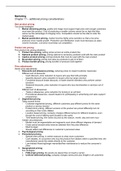Marketing
Chapter 11 – additional pricing considerations
New product pricing
Two broad strategies:
1. Market skimming pricing, quality and image must support high price and enough customers
must want the product. Cost of producing a smaller volume cannot be so high that they
cancel out the advantage of charging more. Competitors should not be able to enter the
market easily
2. Market penetration pricing, market must be highly price sensitive so that a low price
produces more market growth. Production and distribution costs must decrease as sales
volume increases. Low price must keep out competition.
Product mix pricing
Five product mix pricing situations:
1. Product line pricing, setting prices across an entire product line
2. Optional product pricing, pricing optional or accessory products sold with the main product
3. Captive product pricing, pricing products that must be used with the main product
4. By-product pricing, pricing low-value by products to get rid of them
5. Product bundle pricing, pricing bundles of products sold together
Price adjustments
Seven price adjustments:
1. Discounts and allowance pricing, reducing prices to reward customer responses
Different sort of discounts:
- Cash discount, price reduction to buyers who pay their bills promptly
- Quantity discount, price reduction to buyers who buy large volumes
- Functional discount (trade discount), to trade-channel members who perform certain
functions
- Seasonal discounts, price reduction to buyers who buy merchandise or services out of
season
Different sort of allowances:
- Trade-in allowances, price reduction for turning in an old item
- Promotional allowances, reward dealers for participating in advertising and sales support
programmes
2. Segmented pricing
Takes several forms:
- Customer-segmented pricing, different customers pay different prices for the same
product or service (movie)
- Product-form pricing, different versions of the product are priced differently but not
according in their costs (Water)
- Location-based pricing, company charges different prices for different locations, even
though the cost of offering each location is the same
- Time-based pricing, firm varies its price by the season, month, day and even hour.
Certain circumstances:
- Market must be segmentable and segments must show different degrees of demand
- Costs cannot exceed extra revenue obtained from the price difference
- Must be legal
- Should reflect real differences in customer’s perceived value
3. Psychological pricing
4. Promotional pricing
- Special even pricing, in certain seasons to draw more customers
- Cash rebates, to consumers who buy the product from dealers within a specified time; the
manufacturer sends the rebate directly to the customer.
- Low-interest financing/longer warranties/free maintenance to reduce the consumer’s
price.
5. Geographical pricing
five strategies:
1. FOB-origin pricing, the goods are placed free on board a carrier.
2. Uniform-delivered pricing, company charges same price plus freight to all customers






